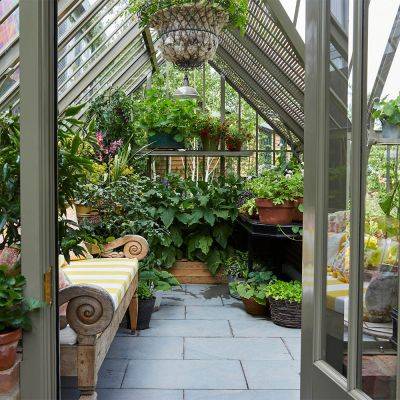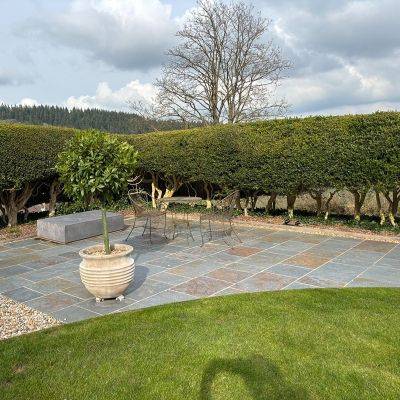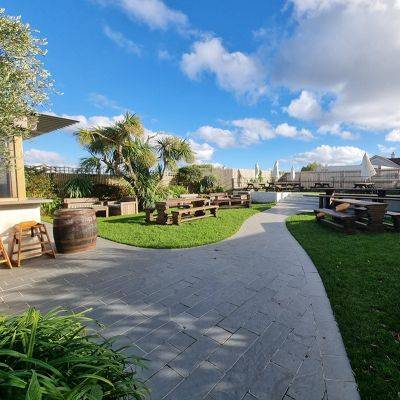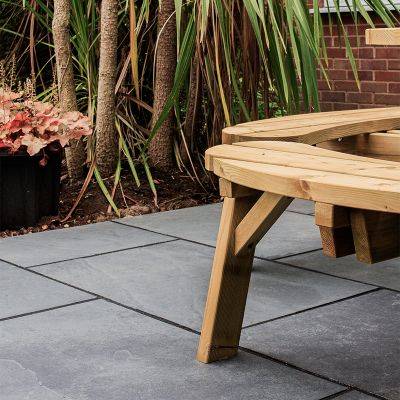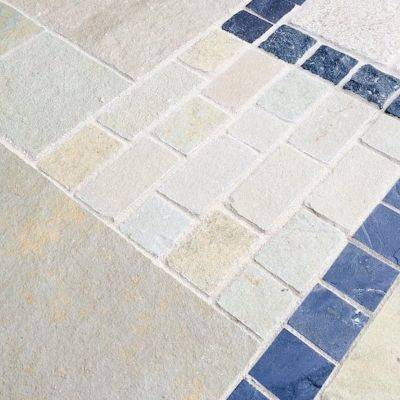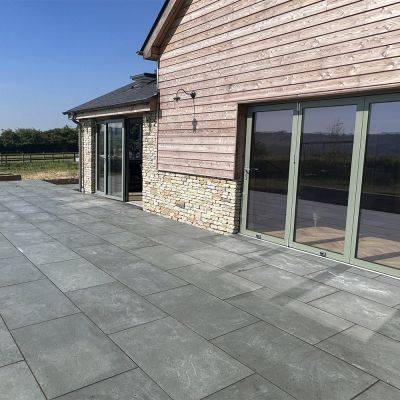Why Choose Slate Paving?
If you're planning a new patio or upgrading an existing outdoor space, slate paving slabs provide a smart and stylish solution. Their naturally riven texture provides an anti-slip surface, which makes them ideal for use in British gardens all year long.
With low water absorption and natural anti-slip properties, slate slabs are well suited to areas pools, ponds and pathways. They’re easy to care for and won’t lose their colour over time, so you can enjoy a new, high-end look with very little upkeep.
Whether you’re creating a modern courtyard or a more traditional setting, garden slates bring character and charm to outdoor spaces. The clean lines and organic finish of slate patio tiles work beautifully alongside planting schemes, edging and garden furniture.
Prefer a warmer tone or a more varied surface? Browse our sandstone paving for rustic colour options and interesting textures.
Colours and Textures of Slate Tiles
Our collection of slate paving slabs are available in a range of colours and textures to suit every garden style. Whether you’re designing a sleek contemporary space or a more rustic look, there’s a finish to complement your vision.
Choose grey slate paving slabs for a soft, neutral look that pairs beautifully with timber furniture, minimal planting, and modern garden pergolas. For a bolder design, black slate paving stones offer striking charcoal tones that create a strong contrast against greenery and light-coloured features.
If you’re drawn to warmer hues, rustic slate paving features a unique blend of browns, golds and greys. Branscombe Slate Paving is a popular choice for characterful rustic outdoor spaces. Each slab is naturally varied in tone and texture, giving your patio or path a truly individual finish.
All of our slate slabs come in either antique or sawn finishes. Riven paving has a more traditional feel, with a textured surface and natural split lines. Sawn slate is smoother, offering a refined finish that works wonderfully in contemporary settings.
Looking for a softer colour with a smoother surface? Browse our full collection of limestone paving options.
Slate Slab Sizes and Styles
We offer a wide range of slate paving slabs in sizes and styles to suit all types of garden projects. Whether you're planning a clean, linear layout or an unstructured, random pattern, you'll find options to match your design.
One of our most popular choices, the Amazon black slate paving 900 x 600 provides a generous surface area that works well in both large patios and compact courtyards. For a more traditional look, mixed-size patio packs create a varied layout that adds texture and interest to your space.
All of our slate slabs are suitable for use in garden paths, patios, pool surrounds and terraces. You could mix large paving slabs with Tintagel Slate Cobbles for edging, pathways or traditional coursed layouts. With consistent thickness and high-quality slate, they’re easy to install and ideal for both DIY enthusiasts and professional landscapers.
Whether you’re working with a modern brief or a traditional setting, our range of styles gives you the flexibility to create a space that feels both personal and practical.
Slate Paving Installation and Maintenance
To achieve the best results from your slate paving slabs, it’s essential to follow a few key steps during installation and ongoing maintenance.
Before laying your slate slabs, ensure the ground is well prepared and level. Use a full mortar bed for stability, and allow a joint width of around 10-15mm, depending on your layout. If cutting is required, we recommend using a diamond-tipped saw. Always mark your cuts clearly with chalk and cut from the thickest side to prevent breakage.
Once installed, slate patio tiles are easy to maintain. Simply sweep regularly to remove debris, and clean with warm soapy water or a diluted stone cleaner like LTP Grimex. Avoid using strong chemicals or high-pressure washers as these can damage the surface.
We recommend sealing your garden slates to protect against moisture, stains and fading. Products such as LTP Mattstone H2O or LTP Colour Intensifier offer long-lasting protection while enhancing the natural tones of the stone.
For pointing, sweep-in jointing compounds such as Ultrascape Premjoint or Flowpoint make the process quicker and cleaner, while delivering a strong, weatherproof finish.
For more detailed advice on installation, sealing and aftercare, read our Ultimate Guide to Slate Paving.Frequently Asked Questions for Slate Paving Stones
Is slate paving slippery when wet?
No, slate paving slabs offer a naturally riven surface that provides good grip underfoot. This makes them a safe and reliable choice for patios, garden paths and pool surrounds.
Do you need to seal slate slabs?
We recommend sealing slate slabs to improve their colour, protect against staining and reduce long-term maintenance. A breathable sealant like LTP Mattstone H2O works well for a natural look, while LTP Colour Intensifier deepens the tones for a richer finish.
How do you clean slate paving slabs?
Slate patio tiles can be cleaned with warm water and a mild detergent or diluted stone cleaner like LTP Grimex. Avoid harsh chemicals or power washers, which can damage the stone surface.
Is slate suitable for British gardens?
Yes, garden slates are frost-resistant, low absorption and extremely hard-wearing. They perform well in all weather conditions, making them a great option for use across the UK.
How long does slate paving last?
With correct installation and minimal maintenance, slate paving slabs can last for several decades. They retain their appearance over time and age naturally without fading.
What’s the difference between Brazilian and Indian slate?
Brazilian slate paving typically has a smoother finish and more consistent colour tones, such as deep greys or blacks. Indian slate paving often has a more rustic look with vibrant, earthy shades and a slightly more textured surface.
Can slate be pressure-washed?
Slate can be pressure-washed, but care should be taken to use a low-pressure setting. Too much force can damage the surface of slate slabs, especially if they are unsealed or weathered.

